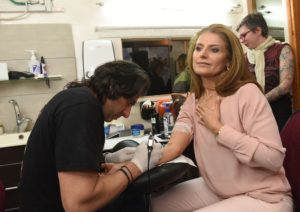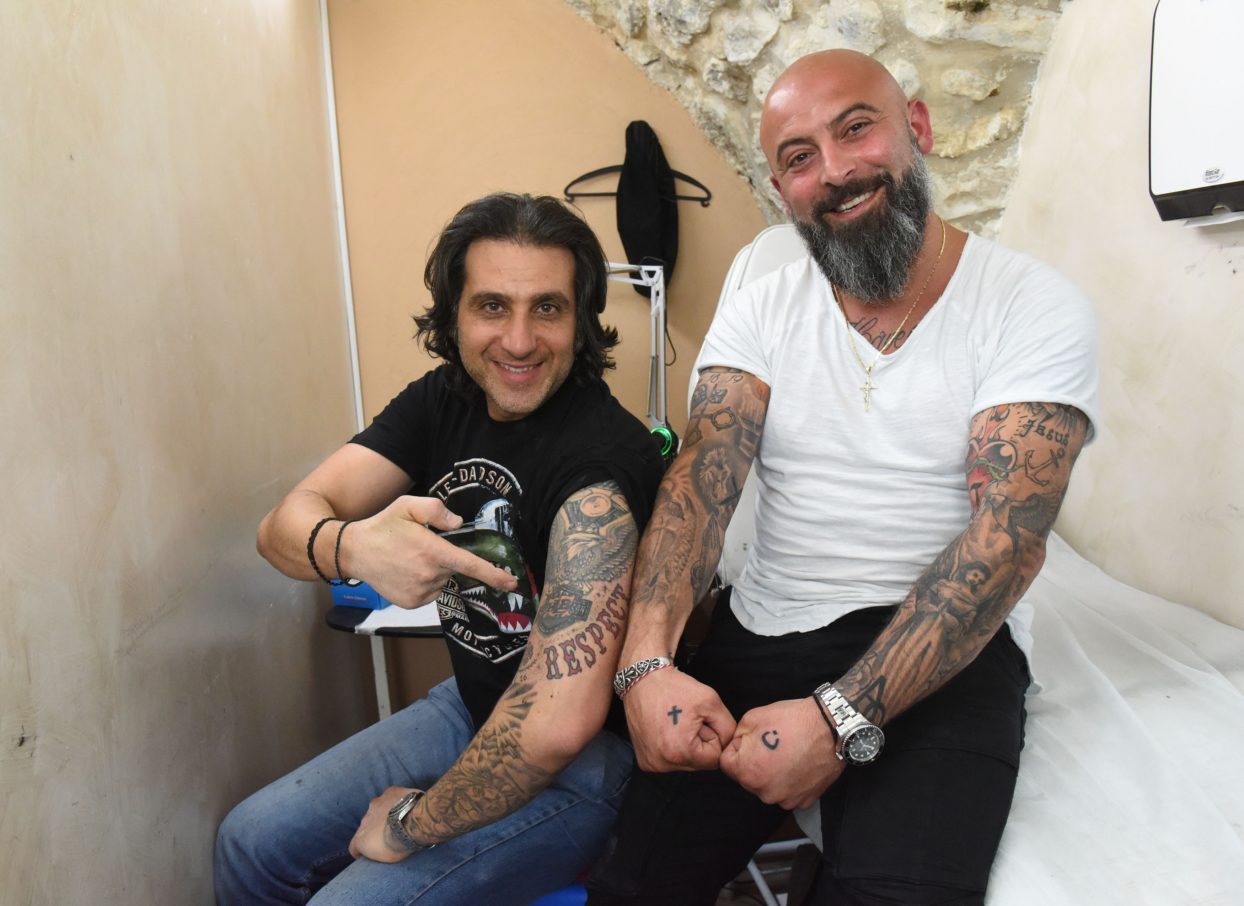The Church doesn’t prohibit them, but does that mean you should get one?
By Jonathan Liedl
Catholic News Agency
Though Millennials and Gen Z’ers are generally less religious than previous generations, young adults who embrace Catholicism actually tend to be more orthodox in their beliefs and more traditional in their devotions than the majority of their Boomer and Gen X elders.
But visit a Theology on Tap or another Catholic young adult event these days, and amongst the Marian consecration chains and scapulars you’ll also likely spot a different sort of visible expression marking the faithful: a smattering of tattoos, nose rings, and other alternative piercings.
From college campuses to the urban young adult scene to which their graduates matriculate, reports are widespread that body ink and piercings have increased in prevalence among young adult Catholics in the past decade, including among those whom self-identify as “conservative Catholics.”
In one sense, this trend indicates that younger Catholic generations aren’t much different than the rest of their peers. Recent national reports have found that more young Americans have tattoos and piercings than ever before. In fact, 40 percent of 18-34-year-olds have at least one tattoo, and the national rate of those with tattoos increased by 21 percent between 2012 and 2019, according to an Ipsos poll. Faithfully practicing Catholics are certainly part of this shift.

A woman with tattoos on her arms attends Pope Francis’ general audience in the Paul VI hall at the Vatican Sept. 8, 2021. (CNS photo/Paul Haring)
Shifting cultural context
Some might find that fact counter-intuitive, even troubling. After all, tattoos, alternative piercings, and the like have long been associated with anti-establishment subcultures, like the punk scene and the criminal underworld. With every septum pierced or forearm tatted, some might ask, aren’t Catholics promoting the same deviant values undergirding these subversive lifestyles?
Not really, says Theresa Zoe Williams. As the 36-year-old Catholic writer argues in “Punk Rock Catholicism,” a chapter found in Hipster Catholics, tattoos and piercings have gone mainstream in recent decades, and therefore need to be viewed in a new cultural context to understand what they actually represent.
Part of that context includes a rise in transience and minimalism. Young people move around more, and bring less stuff with them when they do. Rather than a sign of one’s “toughness” or non-conformity, Mrs. Williams said people ink their body today because their tattoos “give an easily transported, beautiful representation” of important aspects of their life. She also writes that “people are tired of conforming to arbitrary standards that have little to no moral bearing.”
Christopher Ruddy said he began to realize that the cultural context around tattoos and piercings was shifting back in the late 1990s while, as a graduate student at the University of Notre Dame, he started to see women with nose rings kneeling while receiving communion.
“It helped me see that some of the longstanding liberal-conservative typologies [related to tattoos and piercings] were breaking down,” shared The Catholic University of America theologian.
Ink with a meaning
But if young adult Catholics are going along with these cultural trends, especially regarding tattoos, it’s also true that they’re often going about them in a distinct way. Or rather, as practicing Catholics, the important aspects of their lives they want to highlight through permanently inking their body are often tied to their faith, sometimes explicitly.
One only needs to spend a few minutes perusing an online space like “Tatted Catholics” on Instagram to see plenty of examples, from a small rosary tattooed on a finger to an arm-sized depiction of the Blessed Mother. These tattoos aren’t arbitrarily chosen, but typically have deep personal and spiritual significance for the person who gets them.
Take, for instance, Mrs. Williams’ tattoos. The Franciscan University of Steubenville graduate, wife, and mother of three has “grace” in Gaelic tattooed on one wrist, and “mercy” in Polish tattooed on the other. She also has a large monstrance tattoo on her left forearm, with a Latin phrase that means “I am all the family you need.”
The tattoos contain multiple meanings for Mrs. Williams, and she says they help her to live out her faith. For instance, the two languages of her wrist tattoos remind her of her Irish-Polish mother, and to intercede for her. Their location provides an opportunity to contemplate Christ’s wounds and his sacrifice on the cross.
The Polish “mercy” tattoo also provides a point of connection with Sts. Faustina and Pope John Paul II, two Poles who promoted devotion to Divine Mercy. The monstrance tattoo, meanwhile, was inspired by a profound experience Mrs. Williams had as a 17-year-old while in adoration.
A simple way to witness
But just as much as the tattoos help Williams remind herself of her beliefs and devotions, they also help her share her beliefs with others. She recalls that when she was a youth minister for the first time, her tattoos helped spark a conversation about how the Catholic faith integrates into every aspect of our lives.
“That’s the kind of conversation I always hope to generate with my tattoos,” said Mrs. Williams, who added that she is “inevitably” asked about her ink when she meets a new group of people, and so always has a chance to share her story.
Catherine Huss agrees, and finds that her tattoos provide her with a simple way to witness to her faith while working in California’s fashion industry. For instance, the 29-year old has “ADMG” tattooed inside an arrow on her wrist, a reference to “Ad Majorem Dei Gloria,” St. Ignatius of Loyola’s maxim to do all things for the glory of God, which Ms. Huss said “simplifies our life’s duty.” The arrow points away from her, a reminder that everything she does should be done for others.
“It’s in an obvious place that I and others see every day to remind me that this call is constant,” said Ms. Huss, founder of Siena and Co., a swimsuit line she said was inspired by Catholic principles of modesty and ethical production.
Ms. Huss has similar thoughts about her nose piercing. While admitting that there was a bit of “rebellious spirit” behind her decision to get one, she also said it has an evangelical purpose.
“I like being relatable and approachable to non-believers and I do think wearing a nose ring can help facilitate a relatable first impression,” she said.
Sara Heselton, who also has a nose piercing, knows that not everyone will see facial piercings as “relatable,” and actually removed hers when she served with a Catholic missionary organization that put on retreats for high schoolers in order to “not pose an obstacle to the faith.”
But now, as a graduate student and employee at the St. Paul Seminary and School of Divinity in Minnesota, the 28-year old said she wears her nose piercing with little fear of scandalizing anyone — ironic, given that she first got it as a 17-year-old to challenge people’s perceptions of her and show that she “was more ‘edgy’ than they thought.”
“Now, it seems to function like culturally accepted ear piercings that rarely distract but instead accentuate feminine beauty,” Ms. Heselton said.
Catholic teaching
In terms of moral guidance, the Church’s teaching authority doesn’t say anything explicitly about tattoos or body piercings. Neither practice is strictly prohibited, nor considered intrinsically evil.
Regarding tattoos, some point to Leviticus 19:28, which says “You shall not make any cuttings in your flesh on account of the dead or tattoo any marks upon you.” But some theologians point out that this prohibition was in the context of pagan cultures that tattooed the names of the dead as part of their religious practice, and shouldn’t be understood as a condemnation of tattooing in general. Furthermore, it’s part of the Old Covenant law, which also included prohibitions against things like eating pork and trimming one’s beard, and was abrogated with the coming of Christ.
Claims that Pope Adrian I banned tattoos at the Second Council of Nicaea of 787 AD are common on the internet, though there’s no explicit evidence of this in the council text. The same year, however, the local Council of Northumberland taught, “When an individual undergoes the ordeal of tattooing for the sake of God, he is greatly praised. But one who submits himself to be tattooed for superstitious reason in the manner of the heathens will derive no benefit thereof.”
Tattoos have certainly clashed with Christian sensibilities at times. They’ve historically been considered an impediment to ordination, interpreted as an instance of what canon 1041 describes as “bodily mutilation.” Some dioceses, like the Diocese of Cheyenne, maintain this policy, although the diocese also notes that the bishop may grant a dispensation in particular cases.
However, tattoos have also been a feature of the faith in various Christian contexts. Coptic Christians in Egypt, for instance, receive a small cross tattoo on their wrist to designate their Christian identity in a Muslim-majority country, a practice that dates back to the 7th century and the Islamic conquest of North Africa. It was also typical for medieval European visitors to the Holy Land to receive a tattoo of a Jerusalem cross to commemorate their pilgrimage, and crusaders marked their body with a cross to ensure they’d receive a Christian burial if killed in combat.

Wassim Razzouk tattoos Lema Demir, 46, a Syriac Christian who lives in Sweden, in his family’s shop in the Old City of Jerusalem April 9. The Razzouk family has been tattooing Christian pilgrims in the Holy Land for 500 years, and 200 years before that in Egypt. (CNS photo/Debbie Hill)
Discernment Needed
Without a clear and authoritative teaching on tattoos, and for that matter, bodily piercings, Catholics today are largely left with some general principles related to bodily integrity, modesty, and aesthetics to aid in their discernment.
Unsurprisingly, different Catholic catechists come to different conclusions and offer different advice. For instance, Fr. Chad Ripperge argues that tattoos are immodest and “a sin against justice” because they mutilate the body, while Catholic apologist Jimmy Akins concludes that, “from a moral perspective, there is no reason why one cannot color one’s skin, which is what tattooing amounts to.” Moral theologian Christian Brugger has argued that while tattoos aren’t intrinsically evil, they’re also not morally indifferent, and that their prevalence today is a sign of the culture’s deeper denial of the sanctity of the body.
“It might be helpful to ask ourselves if we’re thinking of getting a tattoo: Would it be appropriate for me to paint this permanently on the high altar at St. Peter’s Basilica,” Brugger suggests, applying St. Paul’s instruction that our bodies are temples of the Holy Spirit.
Margaret McCarthy, a theologian at the John Paul II Institute in Washington, D.C., says she is “really agnostic” about tattooing, but does draw out some important distinctions. For instance, she points out the “iconic character” of the cross tattoos that Christians in places like Egypt and Ethiopia receive. This approach to tattooing, she notes, seems to be less about self-expression or treating the body as a “blank slate” without inherent meaning, and more about being marked as a “slave of Christ.”
“They are not any artist’s rendering,” she said. “They have a decided [given] form to them.”
Ms. McCarthy believes this insight is drawn out in Flannery O’Connor’s short story, “Parker’s Back,” in which a heavily inked man gets an icon of Jesus tattooed on his back — the only “blank space” left on his body. When he looks at the tattoo by use of a mirror, he is struck by the gaze of Christ.
“Parker is finally satisfied with an icon, which is a saint looking at you from the depth of heaven (or in this case from the depth of body), versus all the other tattoos he had chosen to ‘express’ himself,” Ms. McCarthy pointed out.
Best practices?
Father Joseph LaJoie ministers in Five Points, one of Denver’s hippest, youngest neighborhoods, where he says tattoos are ubiquitous and “any type of person could be expected to have” one.
When young Catholics come to him for guidance on the topic, he can draw from an important resource — his own experience with body ink.
The 39-year-old priest, pastor of Sacred Heart parish, has five tattoos, not all of which he’s proud of. He got three of his tattoos in his late teens, and although they’re largely innocuous and memorialize events or interests that still have some significance to him — like a class trip to Costa Rica and the band U2 — he said “they’re not worth having in that form of a souvenir twenty years later.”
On the other hand, Father LaJoie has no regrets about his “deconstructed Miraculous Medal” tattoo he’s gotten more recently, because it’s rooted in something more meaningful and permanent.
Drawing from his own experience, Father LaJoie said that tattoos should clearly not be lewd, vulgar, or diabolical, and he also cautions people about getting them in a way that’s too distracting, either because of location or size.
He also encourages those considering getting tatted up to do a bit of an examination of conscience before making such a permanent decision.
“I think people, especially young people, need to think soberly about their motivations,” he said. “Temporary situations, infatuations and interests, names and faces of people can always be very different realities decades down the road.”
In fact, although he has tats of his own and says that fact can help him connect with people from different walks of life, he has often encouraged those whom ask him to not get tattoos, not only to avoid future regret, but “also because to not get tattooed is more counter-cultural [today] than getting one.”
If you are thinking about getting one, Theresa Zoe Williams has some advice: try it out first. As laid out in “Punk Rock Catholicism,” the author suggests first reflecting on an aspect of faith that is central to your devotion and praying about how it could be incorporated onto your body. Then, she suggested using a Sharpie or a washable marker to draw the image on, leaving it there for a week, and then praying about the experience before committing to the image permanently.
Because while tattoo removal exists, it’s an expensive process — though one can probably assume that an unwanted tattoo won’t be part of the glorified body.

